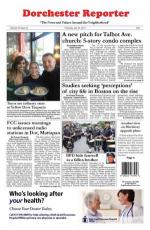February 8, 2012
As people make the shift to reduce energy use through green efforts, preservation groups find it difficult to maintain historic buildings with these new changes. For the Pierce House on Oakton Avenue, Historic New England has found inexpensive ways to increase its energy efficiency while respecting its 300-year-old history.
This Saturday, Historic New England, along with the National Trust for Historic Preservation and Massachusetts Historical Commission, will host a special workshop to highlight the work that has already been done to weather-proof the Pierce Avenue house. The Greening the Older Home presentation will take place at the Adams Street Library and includes a limited tour of the Pierce House, with a focus on how residents can also make efficiency changes in their homes.
The Pierce House, built in 1683, has been open to the public since 1968 when it was sold to Historic New England. Since it was rented out to tenants for 30 years, it was not actively used until around 2002 and has been “dedicated to school programs,” said Education program coordinator Kate Hooper.
“We have worked with a variety of Boston Public Schools and after school programs from the Dorchester area and have even branched out to preschools,” Hooper said. “We are reaching out to all ages.”
The weatherization efforts – the term used by the group – focused on reducing air leakage and eliminating the draft. Since deep energy retrofits are too damaging, Historic New England conducted energy upgrades that are “reversible,” said Preservation maintenance coordinator Joshua Wright.
“These reversible upgrades are minimally invasive,” he said. “They did not damage or change any part of the house that would conflict with its history.”
After two energy audits, the Building Science Corporation in Somerville helped to determine the main concerns and focus areas of the Pierce House and “prioritize what was financially the quickest payback,” Wright said.
The weatherization upgrades include interior storm windows – a new window inside the old window – that help with air sealing, weather-stripped doors, home-made pillows with insulation that can be used in the attic, basement, and chimneys to eliminate the draft. Other upgrades include a new floor over the old one and a high-efficiency condensing furnace, which was switched from oil to natural gas and saved money, he said.
According to a recent audit, Pierce House staff reviewed the effectiveness of the reversible changes in October to discover that air leakage was reduced by about 30 percent without damage. Between March and August 2011, gas and electricity were also reduced by 17 percent.
“This is still new and no one knows how to respond to it over time until we know how to prevent the transfer of moisture when we do things like take a shower or make tea,” Wright said. “We still don’t know how much reduction consumption was achieved or how much money was saved.”
Manager of Historic Preservation Services Sally Zimmerman said that common sense in addition to science can produce solutions within older residential buildings.
“The consumer needs to be aware of how to fit the solution to their house. It can be done on anyone’s house,” Zimmerman said. “It is a good method that uses traditional and inexpensive materials that are reversible.”
Older houses around the neighborhood and in the New England area, have more gaps where air exchange occurs and cold air comes from the outside, Zimmerman said. These upgrades can stop air movement and reduce the wasted energy.
“The Pierce House has been a real success story since it is on a side street and seemed to have no purpose other than its age,” she said. “However, it has become a community resource used all the time by schools and is a part of the history of Boston and the Dorchester neighborhood.”
Greening the Older Home presentation will be held on Feb. 11 from 9:30 to 11 a.m. at the Adams Street Branch Library. The tour of the Pierce House weatherization project is available to the first fifteen people to register.



